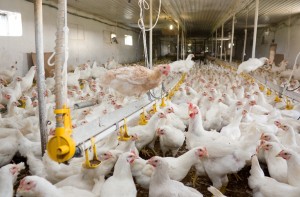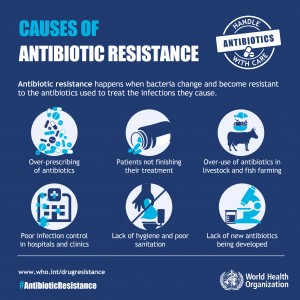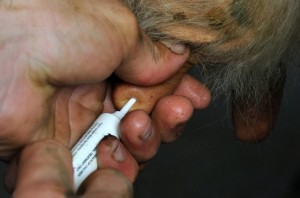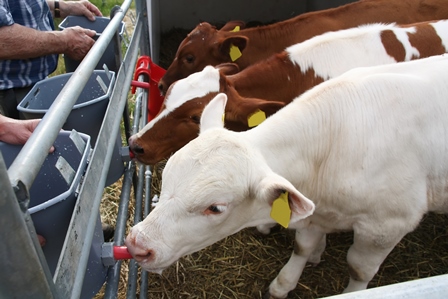
The use of antibiotics to promote growth, increase feed efficiency and reduce mortality in indoor poultry farming is unsustainable, and has been implicated in the increase in antibiotic resistance in humans.
Why Focus on Antibiotics?
One of our key sustainable livestock principles is reducing dependency on veterinary medicines without jeopardising the well-being of animals.
Antibiotics are widely used in healthy food-producing animals to promote growth and prevent disease. This practice contributes to the emergence and spread of resistant bacteria in both animal and human populations. Resistant microorganisms carried by food-producing animals can spread to humans through consumption of contaminated food, from direct contact with animals, or via the environment (e.g. contaminated water). The global trade in animals and food greatly enhances the opportunities for the global spread of resistance.
Not only does the continued use and misuse of antimicrobial drugs hastens the emergence of drug-resistant strains. Ineffective infection control, poor hygiene and inappropriate food-handling conditions enable the further spread of resistance. Further, a reliance on antibiotics within a farming system would suggest that there are fundamental problems with the way animals are being managed and that changes are required that reduce the dependency.
In this section we will provide farmers with information and guidance from existing sources that will enable animals to be kept healthy and under the highest welfare conditions without the reliance of antibiotics and other anti-microbials. We will also provide guidance on the responsible use of anti-microbial drugs in situations where they are deemed necessary.
Antimicrobial Resistance
Antimicrobial resistance is resistance of a micro-organism (including bacteria, fungi, viruses and parasites) to a drug that was originally effective for treatment of infections caused by that micro-organism. Resistant microorganisms are able to withstand attack by antimicrobial drugs so that standard treatments become ineffective, infections persist and there is an increased risk of the infection spreading.
Antimicrobial resistance threatens the effective prevention and treatment of an ever-increasing range of bacterial, parasitic, viral and fungal infections affecting humans and animals. New resistance mechanisms are emerging and spreading making this an increasingly serious threat to global public health.

Causes of antibiotic resistance, image from the World Health Organisation www.who.int/drugresistance

The use of blanket antibiotic dry cow therapy is widespread but there are ways to target treat problematic cows and guidance on practical techniques that can help prevent cases of mastitis. See the mastitis page for more details.
The Responsible Use of Veterinary Medicines
 The responsible use of veterinary medicines is one of our key sustainable livestock practices. The Responsible Use of Medicines in Agriculture Alliance (RUMA) define this as “using medicines as little as possible and as much as necessary”.
The responsible use of veterinary medicines is one of our key sustainable livestock practices. The Responsible Use of Medicines in Agriculture Alliance (RUMA) define this as “using medicines as little as possible and as much as necessary”.
Traditionally, antibiotics in agriculture have been used to treat and cure sick animals (Therapeutic) , to control disease spreading in groups of animals where some are already sick and others are at risk (Metaphylaxis) and to prevent disease or sickness in an otherwise healthy group of animals (Prophylaxis). A number of our key principles and practices are concerned with solving disease problems caused by husbandry by changing the management rather than through the use of preventive antibiotics.
Responsible use means:
– Minimizing disease risk so that less treatments are required. This requires emphasis on good health planning emphasizing preventive management such as good hygiene, properly ventilated buildings, effective biosecurity, appropriate vaccination programmes based on evidence-based risk, appropriate nutrition, the use of resistant breeds, low stocking rates and access to clean water.
– Treat sick animals in accordance with instructions on the label and from the farm’s veterinary surgeon;
– Only using antibiotics that are prescribed by a farm veterinarian;
– Ensuring that a full course of antibiotic treatment is administered and there is no under-dosing;
– Critically important antibiotics for human treatment should not be used as a first line treatment in animals, unless there is clear scientific justification to do so.
– Antibiotics should not be used as a preventive measure unless it is absolutely necessary to do so.
Avoiding Preventive Use of Antibiotics
Disease problems due to husbandry should be solved by changing the management rather than by the preventive use of antibiotics.
Preventive treatment with antibiotics in animals should:
– only be applied to animals diagnosed as being at high risk of bacterial disease
– only occur when prescribed by a veterinarian and on the basis of epidemiological and clinical knowledge
– not be applied routinely
– not be used to compensate for poor hygiene or inadequate husbandry conditions .
Critically important antibiotics for human treatment should not be used preventatively in animals or as the first line of treatment, unless there is clear scientific justification to do so.

Although not linked directly, there is a potential relation between intramammary antibiotic use and antibiotic resistance through the feeding of waste milk to calves.


 American English
American English

Comments are closed.